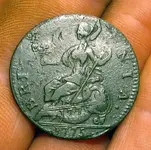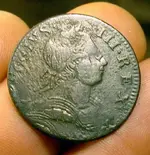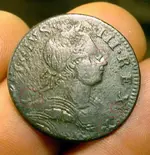tigerbeetle
Full Member
- Joined
- Jan 2, 2009
- Messages
- 166
- Reaction score
- 275
- Golden Thread
- 0
- Location
- Jersey Shore
- Detector(s) used
- Many -- Fisher, White's, Minelab, Cobra, others
- Primary Interest:
- Metal Detecting
I recently began cataloguing my large cent, some 200 of them and made an amazing find within a find.
Having never been much on foreign colonial coins, I had not cleaned up past finds that were British in origin. To make a proper account of the LCs I’ve found over the years, I decided to restore my forsaken foreigners, mainly the ones not actually corroded; coins that are caked in dirt but don’t have the coin surface compromised.
As I’ve noted in recent posts, we have very forgiving ground here in Southern New Jersey, where an electrolytic relationship between copper coins and naturally occurring iron in the soil often protects the coin better than most places in the country. I bring that up as a segue into an outstanding oddity I found upon a British “Britannia” large cent specimen. The full impact of the find is enhanced by the decent condition of the coin.
As I began restoring it, I went to the obverse side, where the famed seated Goddess of Liberty reigns, above the date. I first Q-tipped (special chemicals in the cotton) the date. I saw it was a very common 1775, so I sped up, abandoning some of the meticulous care I usually use when properly restoring a coin – without cleaning it. Yes, there is a huge difference. Cleaning a coin is the kiss of value death.
It was at the top of the large cent coin, head level, that I noticed something super weird. Lady liberty had a well-marked arm coming out of her head. That didn’t seem quite anatomically correct – even for a lithe goddess. This was a big error. So big, I even imagined some sort of symbolic meaning being forwarded by the original minters. Fat chance. What was being said by those England coin-makers was “We’re sending these coins to the colonies. We don’t care if they’re total crap.”
After my arm-headed discovery, I then carefully restored the entire obverse. Not only did I have a coin with a freaky lady but also a double date that had so much separation between the two dates they need long-distance service just to talk to each other. Check it out:

Obverse also has some weird errors -- as the king's number is up (his nose).

Having never been much on foreign colonial coins, I had not cleaned up past finds that were British in origin. To make a proper account of the LCs I’ve found over the years, I decided to restore my forsaken foreigners, mainly the ones not actually corroded; coins that are caked in dirt but don’t have the coin surface compromised.
As I’ve noted in recent posts, we have very forgiving ground here in Southern New Jersey, where an electrolytic relationship between copper coins and naturally occurring iron in the soil often protects the coin better than most places in the country. I bring that up as a segue into an outstanding oddity I found upon a British “Britannia” large cent specimen. The full impact of the find is enhanced by the decent condition of the coin.
As I began restoring it, I went to the obverse side, where the famed seated Goddess of Liberty reigns, above the date. I first Q-tipped (special chemicals in the cotton) the date. I saw it was a very common 1775, so I sped up, abandoning some of the meticulous care I usually use when properly restoring a coin – without cleaning it. Yes, there is a huge difference. Cleaning a coin is the kiss of value death.
It was at the top of the large cent coin, head level, that I noticed something super weird. Lady liberty had a well-marked arm coming out of her head. That didn’t seem quite anatomically correct – even for a lithe goddess. This was a big error. So big, I even imagined some sort of symbolic meaning being forwarded by the original minters. Fat chance. What was being said by those England coin-makers was “We’re sending these coins to the colonies. We don’t care if they’re total crap.”
After my arm-headed discovery, I then carefully restored the entire obverse. Not only did I have a coin with a freaky lady but also a double date that had so much separation between the two dates they need long-distance service just to talk to each other. Check it out:

Obverse also has some weird errors -- as the king's number is up (his nose).

Amazon Forum Fav 👍
Upvote
0







